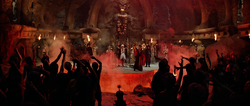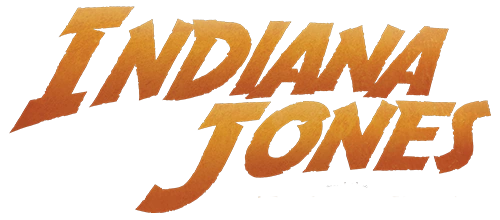No edit summary Tag: Visual edit |
m (Reverted edits by Liam.reynolds.946 (talk) to last version by Vetinari) |
||
| Line 20: | Line 20: | ||
[[1935|Five years later]], Jones [[Indiana Jones and the Temple of Doom|encountered]] another resurgent Thuggee congregation at [[Pankot Palace]], led by the high priest [[Mola Ram]]. Ram sought to achieve Indian independence from British rule, albeit by violent means as opposed to the better known peaceful methods of [[Mohandas K. Gandhi|Mahatma Ghandi]]. Afterwards, Mola Ram planned to systematically eradicate the world's religions in favor of Thuggeeism.<ref name="Temple of Doom">''[[Indiana Jones and the Temple of Doom]]</ref> |
[[1935|Five years later]], Jones [[Indiana Jones and the Temple of Doom|encountered]] another resurgent Thuggee congregation at [[Pankot Palace]], led by the high priest [[Mola Ram]]. Ram sought to achieve Indian independence from British rule, albeit by violent means as opposed to the better known peaceful methods of [[Mohandas K. Gandhi|Mahatma Ghandi]]. Afterwards, Mola Ram planned to systematically eradicate the world's religions in favor of Thuggeeism.<ref name="Temple of Doom">''[[Indiana Jones and the Temple of Doom]]</ref> |
||
| − | The Pankot cult was able to operate in secrecy through the cooperation of Pankot's Prime Minister, [[Chattar Lal]]. It was disbanded when Mola Ram was killed and the members were either killed or |
+ | The Pankot cult was able to operate in secrecy through the cooperation of Pankot's Prime Minister, [[Chattar Lal]]. It was disbanded when Mola Ram was killed and the members were either killed or captured by [[Phillip James Blumburtt|Captain Phillip Blumburtt]]'s troops.<ref name="Temple of Doom" /> Though Lal escaped, the British kept a vigilant eye out for Lal should he try to establish another Kali temple.<ref name="Temple Sourcebook" /><ref>{{IJ|url=marshall/character/chattarlal/|text=Chattar Lal's Marshall College entry}}</ref> |
==Appearances== |
==Appearances== |
||
Revision as of 12:45, 30 May 2020
- "Oh, the Thuggee. Marvelous brutes. Went about strangling travelers. ... The British army did away with them nicely."
- ―Phillip James Blumburtt[src]

Thuggee warriors assembling around a ravine.
The Thuggee cult was a secret religious society centered in India. They spoke in a secret language and members (sometimes referred to as Thugs) gathered and worshiped the Hindu goddess Kali Ma with barbaric human sacrifices at secret temples. The British, led by Major William Sleeman attempted to eradicate the group in the early 19th century, forcing the Thuggee to go underground. A loyal priest of Kali hid two of five Sankara Stones in a diamond mine in Pankot Province, which was later converted to a secret Kali temple.
History
The Thuggee cult was a centuries-old group of assassins believed to have originated from "Mohammaden" tribes which became unacceptable to the peaceful Islam religion. Members roamed India, Bengal and parts of Tibet preying on travelers and merchants that they deemed to be unrepentant, strangling them with a silk cloth and taking their valuables. Victims' bodies were mutilated in honor of the Hindu goddess of destruction Kali. However, the Thuggee also had a reputation for protecting pilgrims which left opinion of the group as mixed.[1][2]
In the 13th century, the Thuggee were recognized as a tax-paying religious organization but by the 1700s, their attacks had left many fearful of traveling by road and the development of the Indian rail network meant that victims were increasingly harder to come by. Instead, the Thuggee turned on the pilgrims and became despised by many for being oathbreakers and murderers. It was said that the cult had simply been sparing those on pilgrimage to avoid bringing another deity's wrath down upon Kali.[1][2]
In response, the Thuggee took to more secretive methods to disguise themselves, ambushing victims outside of small towns and villages and taking their captives elsewhere for sacrifice. Meanwhile, the British had arrived in India and they held little interest in Thuggee activities, dismissing attacks as being those of wild animals. Though British merchants were also being targeted, it was not until army patrols disappeared and officials began demanding an explanation that something was to be done about the Thuggee.[2]
Between 1820—1850, British forces aggressively swept through India to eradicate the Thuggee. Kali's worship was outlawed, her temples destroyed and captured Thuggee priests were executed.[2] Nevertheless, the cult survived in smaller pockets.[3]
In 1930, Indiana Jones and Marya Smirnova confronted the fellowship of a resurrected Thuggee temple in Bhubaneshwar. They discovered that the Anglo-Indian captain Blake had revived Thug practices to strike back at the peoples of both countries who had rejected his mixed-race heritage.[4]

The Thuggee practiced human sacrifice.
Five years later, Jones encountered another resurgent Thuggee congregation at Pankot Palace, led by the high priest Mola Ram. Ram sought to achieve Indian independence from British rule, albeit by violent means as opposed to the better known peaceful methods of Mahatma Ghandi. Afterwards, Mola Ram planned to systematically eradicate the world's religions in favor of Thuggeeism.[5]
The Pankot cult was able to operate in secrecy through the cooperation of Pankot's Prime Minister, Chattar Lal. It was disbanded when Mola Ram was killed and the members were either killed or captured by Captain Phillip Blumburtt's troops.[5] Though Lal escaped, the British kept a vigilant eye out for Lal should he try to establish another Kali temple.[2][6]
Appearances
- Indiana Jones et la Cité de la Foudre
- Indiana Jones and the Temple of Doom (First appearance)
- Indiana Jones and the Temple of Doom novel
- Indiana Jones' Greatest Adventures
- Indiana Jones and the Fate of Atlantis (Mentioned only)
Sources
- Indiana Jones and the Rising Sun
- Indiana Jones and the Temple of Doom Sourcebook
Chattar Lal's Marshall College entry on IndianaJones.com (backup link on Archive.org)
Mola Ram's Marshall College entry on IndianaJones.com (backup link on Archive.org)
Zalim Singh's Marshall College entry on IndianaJones.com (backup link on Archive.org)
- Indiana Jones: The Ultimate Guide
- The Lost Journal of Indiana Jones
Notes and references
- ↑ 1.0 1.1 The Lost Journal of Indiana Jones
- ↑ 2.0 2.1 2.2 2.3 2.4 Indiana Jones and the Temple of Doom Sourcebook
- ↑ Indiana Jones: The Ultimate Guide
- ↑ Indiana Jones et la Cité de la Foudre
- ↑ 5.0 5.1 Indiana Jones and the Temple of Doom
- ↑
Chattar Lal's Marshall College entry on IndianaJones.com (backup link on Archive.org)
